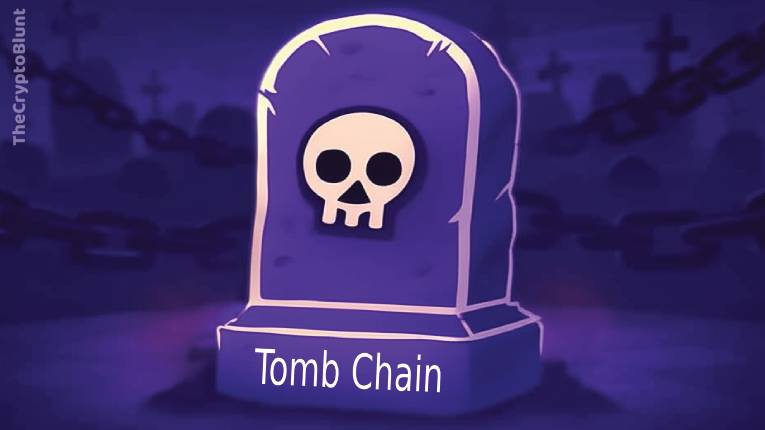However, I soon realized most stablecoins were centralized, relying on traditional banks to hold reserves. This felt a bit like putting old wine in new bottles – the core problem of centralization wasn’t fully solved. That’s when I learned about algorithmic stablecoins and projects like Tomb Chain, which aimed to create a stable asset not by holding fiat reserves, but through clever economic algorithms, often pegged to another volatile cryptocurrency. This was a true “aha!” moment, showing how innovation could push the boundaries of decentralized finance, even with the inherent risks.
- Part 1: The Foundations of the Digital Economy – Understanding Cryptocurrency and Blockchain
- Part 2: Demystifying Common Crypto Misconceptions
- Part 3: Why Crypto Matters – Real-World Applications and Benefits
- Part 4: The Tomb Chain Ecosystem – Algorithmic Stability and DeFi Hub
- Part 5: Getting Started in the Crypto World – A Beginner’s Perspective
This comprehensive guide is designed specifically for absolute beginners. We’ll cut through the jargon, tackle common misconceptions head-on, and show you why this technological revolution matters for everyone, not just tech enthusiasts or financial gurus. We’ll explain the fundamental concepts of crypto, dive deep into the Tomb Chain Ecosystem, and reveal how its unique approach to algorithmic stablecoins aims to build a robust and liquid financial environment on a high-performance blockchain. We believe in transparent education, providing you with accurate, well-researched information to help you navigate this exciting new frontier.
Let’s embark on this journey to understand the digital revolution, starting with the very basics.
Part 1: The Foundations of the Digital Economy – Understanding Cryptocurrency and Blockchain
Before we dive into the intricacies of the Tomb Chain Ecosystem, it’s crucial to grasp the bedrock principles: cryptocurrency and blockchain. Think of them as the engine and the ledger of this new digital world.
What is Cryptocurrency? More Than Just Digital Money
At its simplest, cryptocurrency is a form of digital or virtual currency that uses cryptography for security. Unlike traditional currencies (like the Indian Rupee or US Dollar) issued and controlled by central banks, most cryptocurrencies are decentralized. This means they are not subject to government or financial institution interference.
Imagine a currency that lives purely online, secured by incredibly complex mathematical puzzles. That’s a cryptocurrency. Bitcoin, launched in 2009, was the first and remains the most well-known cryptocurrency. Since then, thousands of others have emerged, each with its own unique purpose and technology.
Key characteristics of cryptocurrencies:
- Digital: They exist only in digital form, not as physical coins or notes.
- Decentralized: No single entity controls them. Their operations are distributed across a network of computers.
- Secured by Cryptography: Advanced encryption techniques protect transactions and control the creation of new units.
- Peer-to-Peer: Transactions occur directly between users without intermediaries like banks.
- Immutable: Once a transaction is recorded, it cannot be altered or reversed.
Unpacking the Blockchain: The Transparent, Immutable Ledger
If cryptocurrency is the digital money, then blockchain is the revolutionary technology that underpins it. Think of a blockchain as a digital, public, and distributed ledger. Instead of a single bank keeping a record of all transactions, a blockchain shares this record across a vast network of computers worldwide.
The “block” in blockchain refers to batches of transactions. Once a block of transactions is verified, it is added to the “chain” of previous blocks, forming a continuous, chronological record. Each new block contains a cryptographic hash of the previous block, linking them together and making the chain incredibly secure and resistant to tampering. If someone tried to alter a transaction in an old block, it would invalidate all subsequent blocks, making the change immediately noticeable to the entire network.
(Consider adding an infographic here: A visual representation of blocks linked together, showing data and cryptographic hashes.)
Core principles of blockchain technology:
- Decentralization: No central authority manages the blockchain. The network of participants collectively maintains and validates it.
- Transparency: Every transaction ever recorded on the blockchain is visible to anyone on the network. While individual identities are often pseudonymized (represented by wallet addresses), the transaction data itself is public.
- Immutability: Once a transaction is added to the blockchain, it cannot be changed or removed. This creates an unchangeable historical record.
- Security: Cryptography ensures the integrity and authenticity of transactions and the overall ledger.
- Distributed Ledger Technology (DLT): The ledger is duplicated and shared across all participants in the network, making it highly resilient to failure.
Decentralization: The Power Shift
We’ve mentioned decentralization repeatedly, and for good reason. It’s a foundational concept that sets cryptocurrencies and blockchain apart from traditional financial systems.
In a centralized system, a single entity (like a bank, government, or corporation) holds all the power and control. They decide who can participate, what the rules are, and they maintain all the records.
In a decentralized system, control is distributed among all participants. There’s no single point of failure or control. This has profound implications:
- Increased Security: No single target for hackers to attack.
- Reduced Corruption: No single entity to bribe or coerce.
- Censorship Resistance: Transactions cannot be blocked or reversed by a central authority.
- Greater Accessibility: Anyone with an internet connection can participate, regardless of their location or financial status.
Consensus Mechanisms: How Blockchains Agree
For a decentralized network to function, all participants need to agree on the valid state of the blockchain. This “agreement” is achieved through consensus mechanisms. You might have heard of “mining” in relation to Bitcoin, which uses a “Proof of Work” (PoW) mechanism. PoW involves powerful computers competing to solve complex cryptographic puzzles to add new blocks. While secure, it’s energy-intensive.
Tomb Chain itself is built on a high-performance, EVM-compatible blockchain. While specific details on Tomb Chain’s exact consensus mechanism are often tied to its underlying network (like Fantom Opera, which uses a variant of Proof of Stake called Lachesis), the general principle for such networks is usually a form of Proof of Stake (PoS) or a highly optimized BFT (Byzantine Fault Tolerance) consensus.
In a PoS system:
- Validators: Instead of “mining,” participants known as “validators” stake (lock up) a certain amount of the network’s native token.
- Block Creation: Validators are then randomly selected (based on factors like the amount staked and time staked) to create and validate new blocks.
- Incentives and Penalties: Honest validators earn rewards for securing the network, while malicious or incompetent validators can have a portion of their staked tokens “slashed” (taken away). This mechanism incentivizes honest participation.
- Efficiency: PoS mechanisms are significantly more energy-efficient than PoW, aligning with growing global environmental concerns.
Tomb Chain leverages the speed and efficiency of its underlying blockchain infrastructure to ensure fast and low-cost transactions for its ecosystem.
Part 2: Demystifying Common Crypto Misconceptions
The rapid rise of cryptocurrencies has, understandably, been accompanied by a surge of misinformation and skepticism. Let’s tackle some of the most prevalent myths head-on, replacing fear with facts.
Misconception 1: “Cryptocurrency is only for criminals and illicit activities.”
This is perhaps the most persistent and damaging myth. While it’s true that, like any form of money (cash, gold, traditional banking), cryptocurrencies can be used for illicit activities, the vast majority of cryptocurrency transactions are legitimate.
The reality:
- Transparency of Blockchain: Unlike cash, which is anonymous, blockchain transactions are publicly recorded and traceable. Every transaction leaves a digital footprint. This makes it harder to conduct large-scale, untraceable illicit activities with crypto compared to traditional banking systems, where money can be laundered through complex shell corporations.
- Law Enforcement Adaptation: Law enforcement agencies worldwide are increasingly sophisticated at tracing crypto transactions and have successfully recovered billions in illicit funds.
- Growing Legitimate Use: Cryptocurrencies are being adopted by major companies for payments, used in international remittances, and are forming the backbone of new financial systems (DeFi). Tomb Chain, for example, focuses on building a decentralized financial ecosystem around its algorithmic stablecoin, which is a legitimate and innovative area of finance. The sheer volume of legitimate transactions far outweighs illicit ones.
Misconception 2: “Cryptocurrency is a scam or a Ponzi scheme.”
The volatility of cryptocurrency prices and the emergence of fraudulent projects have led some to label the entire space as a scam. This is an oversimplification that ignores the underlying technology and its genuine utility.
The reality:
- Distinguish Technology from Scams: Blockchain technology itself is a legitimate and innovative invention with wide-ranging applications beyond just cryptocurrency.
- Investor Beware: Like any new and unregulated market, the crypto space has its share of bad actors and speculative bubbles. There have been Ponzi schemes and fraudulent projects that prey on unsuspecting investors. This highlights the importance of thorough research (Do Your Own Research – DYOR) and due diligence before investing in any project.
- Utility and Innovation: Tomb Chain’s core idea is to create an algorithmic stablecoin and a DeFi ecosystem around it. While algorithmic stablecoins are complex and carry unique risks (as seen with other projects in the past), the underlying concept is an attempt at decentralized financial innovation. Many legitimate crypto projects are building real-world solutions, offering new financial services, revolutionizing data management, and creating new forms of digital ownership. These are not scams; they are technological innovations.
Misconception 3: “Cryptocurrency is bad for the environment.”
Concerns about the energy consumption of cryptocurrency mining, particularly Bitcoin’s Proof of Work mechanism, are valid and important. However, the narrative often oversimplifies the issue.
The reality:
- Energy-Efficient Alternatives: Tomb Chain, being built on modern, high-performance blockchains (like Fantom, which uses a form of Proof of Stake), is significantly more energy-efficient than Proof of Work blockchains. Its operations do not rely on massive energy consumption for computations. By relying on validators who stake tokens rather than competing to solve puzzles, it drastically reduces its carbon footprint.
- Comparison to Traditional Finance/Tech: The traditional financial system and global tech infrastructure (e.g., data centers for cloud computing, online streaming) also have a massive carbon footprint. It’s a complex comparison, but it’s important to consider both sides.
- Focus on Solutions: The focus should be on encouraging sustainable practices and the adoption of greener technologies within the crypto space. Tomb Chain’s underlying technology is designed with energy efficiency in mind.
Misconception 4: “Cryptocurrency will replace all traditional money.”
While cryptocurrencies offer compelling advantages and are undoubtedly part of the future of finance, the idea that they will completely replace all traditional fiat currencies in the short to medium term is unrealistic.
The reality:
- Coexistence and Integration: It’s far more likely that cryptocurrencies will coexist with and integrate into traditional financial systems. We are already seeing this with institutional adoption and regulated crypto products.
- Regulatory Landscape: Governments and central banks are still figuring out how to regulate cryptocurrencies. Full-scale replacement would require a fundamental shift in global economic policy and public trust.
- Specialized Use Cases: Tomb Chain is specialized for its algorithmic stablecoin and the DeFi ecosystem built around it. Its native tokens (TOMB, TSHARE, TBOND, etc.) are designed to power this specific ecosystem, not necessarily to replace your everyday cash for groceries in . They serve a distinct purpose within a new digital economy.
Part 3: Why Crypto Matters – Real-World Applications and Benefits
Beyond the hype and the technical jargon, why should you care about cryptocurrencies and blockchain? The answer lies in their ability to solve real problems and open up entirely new possibilities.
The Volatility Problem and the Rise of Stablecoins
One of the biggest challenges for mass adoption of cryptocurrencies has been their inherent volatility. While this offers potential for high returns, it makes them impractical for everyday transactions or for businesses that need predictable cash flows. Imagine if your rent changed value every hour!
This is where stablecoins come in. They are cryptocurrencies designed to maintain a stable value, typically pegged to a fiat currency like the US Dollar (e.g., USDT, USDC). However, most popular stablecoins are centralized, meaning they are issued by companies that hold an equivalent amount of fiat currency in traditional bank accounts as reserves. This introduces a point of trust and potential censorship, going against the decentralized ethos of crypto.
Algorithmic Stablecoins: A Decentralized Solution (with Nuance)
Algorithmic stablecoins represent a more decentralized approach to stability. Instead of relying on centralized reserves, they use smart contracts and economic mechanisms to maintain their peg.
How it generally works (and how Tomb Finance, the original project that inspired “Tomb Chain,” typically operates):
- Pegged Asset: An algorithmic stablecoin like TOMB (the token at the heart of the Tomb ecosystem) aims to peg its value to another asset, often a well-established cryptocurrency like Fantom (FTM). So, 1 TOMB ideally equals 1 FTM.
- Supply and Demand Adjustments:
- When TOMB’s price goes above its peg (e.g., 1 TOMB > 1 FTM): The protocol incentivizes the creation of new TOMB tokens, increasing its supply. This increased supply aims to drive the price back down to the peg. Users might be incentivized to “mint” new TOMB.
- When TOMB’s price goes below its peg (e.g., 1 TOMB < 1 FTM): The protocol incentivizes the burning or removal of TOMB tokens from circulation, decreasing its supply. This reduced supply aims to drive the price back up to the peg. Users might be incentivized to “buy bonds” (TBOND) with TOMB, effectively taking TOMB out of circulation, and then redeem these bonds for TOMB plus a premium when the peg is restored.
- Multi-Token System: Algorithmic stablecoin protocols often involve multiple tokens to manage these mechanics:
- The Stablecoin (e.g., TOMB): The token aiming for a stable peg.
- Share Token (e.g., TSHARE): This token often represents a share of the protocol’s seigniorage (the profit generated from minting new stablecoins). TSHARE holders typically stake their tokens to earn newly minted TOMB when the protocol is above peg.
- Bond Token (e.g., TBOND): These are issued when the stablecoin is below peg. Users can buy TBONDs with the stablecoin, burning the stablecoin and reducing its supply. When the peg is restored, TBOND holders can redeem their bonds for TOMB at a premium.
This intricate dance of incentives and disincentives, managed by smart contracts, aims to maintain the peg in a decentralized manner. It’s a complex system with inherent risks, as demonstrated by the de-pegging events of some algorithmic stablecoins in the past. However, the innovation lies in its attempt to provide a decentralized form of stability without centralized reserves.
Decentralized Finance (DeFi) on Tomb Chain
Tomb Chain and its associated protocols are designed to be a hub for Decentralized Finance (DeFi) on their chosen underlying blockchain (e.g., Fantom). DeFi refers to financial applications built on decentralized blockchains, aiming to recreate traditional financial services (lending, borrowing, trading, yield farming) without intermediaries.
How Tomb Chain enhances DeFi:
- Liquidity and Trading: By creating a robust algorithmic stablecoin, Tomb aims to provide deep liquidity for trading pairs, especially with its pegged asset (e.g., FTM/TOMB pools). This enables efficient and low-cost swaps within its ecosystem.
- Yield Farming: The multi-token system (TOMB, TSHARE, TBOND) often creates opportunities for yield farming. Users can provide liquidity to pools, stake their LP tokens, or stake TSHARE to earn rewards, driving engagement and liquidity.
- Seamless Integration: Being built on an EVM-compatible chain means that developers can easily deploy existing DeFi protocols or create new ones that leverage Tomb’s unique stablecoin mechanics.
- Financial Innovation: Tomb Chain represents a fascinating experiment in decentralized monetary policy, pushing the boundaries of what’s possible in DeFi beyond simple lending and borrowing.
Fast and Low-Cost Transactions
Tomb Chain leverages the underlying blockchain it operates on (like Fantom), which is known for its high transaction speed and low fees. This means:
- Rapid Transactions: Swaps, staking, and other interactions within the Tomb Chain ecosystem are confirmed quickly, providing a smooth user experience.
- Cost-Effective Operations: The low gas fees make it economically viable for users to participate in various DeFi activities, even small transactions, without being priced out.
Part 4: The Tomb Chain Ecosystem – Algorithmic Stability and DeFi Hub
Now that we have a solid understanding of the fundamentals, let’s dive into the Tomb Chain Ecosystem itself, focusing on its multi-token structure, its unique approach to stability, and how it fosters a decentralized financial environment.
The Core Tokens: TOMB, TSHARE, and TBOND
The Tomb Ecosystem typically revolves around a three-token model to maintain its algorithmic peg, though the exact implementation can vary slightly between different iterations or forks.
- TOMB (The Algorithmic Stablecoin):
- Purpose: The primary token of the ecosystem, designed to maintain a peg to a target asset, often the native coin of the underlying blockchain (e.g., FTM on Fantom Opera). The goal is for 1 TOMB to be equal to 1 FTM.
- Mechanism: Its supply is dynamically adjusted through a seigniorage mechanism. When TOMB’s price is above its peg, new TOMB is minted. When it’s below peg, mechanisms are triggered to reduce its supply.
- Utility: Used for trading, as a liquidity pair, and potentially as a medium of exchange within the ecosystem.
- TSHARE (The Share Token):
- Purpose: Represents a share of the “value” of the Tomb protocol. TSHARE holders are incentivized to support the stability of TOMB.
- Mechanism: When TOMB is above its peg, new TOMB tokens are minted. A portion of these newly minted TOMB tokens are distributed as rewards to TSHARE holders who have staked their TSHARE in the “Masonry” (or similar staking pool). This incentivizes TSHARE holders to keep TOMB at its peg, as their rewards depend on it.
- Utility: Primarily for staking to earn TOMB rewards and for potential governance rights (though governance models can vary).
- TBOND (The Bond Token):
- Purpose: Designed to help bring TOMB back to its peg when it falls below 1 FTM (or its target asset).
- Mechanism: When TOMB’s price drops below its peg, users are incentivized to buy TBONDs with TOMB. This action burns the TOMB, reducing its supply and putting upward pressure on its price. TBONDs are sold at a discount. When the TOMB price recovers above the peg, TBOND holders can redeem their TBONDs for TOMB at a premium, making it profitable to buy TBONDs when TOMB is cheap and hold them until it recovers.
- Utility: A mechanism for stabilizing the TOMB price during contractions.
The Key Protocols and Components
While the exact structure can vary, a typical Tomb Chain ecosystem includes:
- The Treasury / Boardroom / Masonry: This is the core smart contract where TSHARE holders stake their tokens to receive TOMB rewards when the protocol is expanding (TOMB is above peg). This acts as the distribution mechanism for newly minted TOMB.
- The Bonds System: Smart contracts that manage the issuance and redemption of TBONDs, crucial for price stabilization during contractions.
- Liquidity Pools: Automated Market Maker (AMM) pools (like those on a decentralized exchange) where users can provide liquidity for TOMB-FTM pairs (or TOMB-stablecoin pairs). Liquidity Providers (LPs) earn trading fees and often receive additional rewards in TSHARE or other tokens.
- Decentralized Exchange (DEX): The ecosystem likely includes or integrates with a DEX (e.g., Tomb Swap or a similar platform) where users can trade TOMB, TSHARE, TBOND, and other assets.
- Bridges (if applicable): While Tomb Chain itself is a specific blockchain, if it integrates with other chains, cross-chain bridges would allow assets to flow in and out of the ecosystem, enhancing liquidity and reach.
(Consider adding an infographic here: A diagram illustrating the flow of TOMB, TSHARE, and TBOND, showing how they interact in expansion and contraction phases.)
How the Ecosystem Works in Practice
Imagine you’re want to engage with Tomb Chain:
- Acquire FTM: You’d first need to acquire FTM (Fantom’s native token) from a centralized exchange or by swapping other cryptos.
- Bridge to Fantom (if necessary): If your FTM is on another chain, you’d bridge it to the Fantom Opera network.
- Acquire TOMB: You could then use your FTM to buy TOMB on a DEX within the Fantom ecosystem that supports Tomb tokens.
- Participate in DeFi:
- Provide Liquidity: You could pair your TOMB with FTM (e.g., TOMB-FTM LP) and deposit these tokens into a liquidity pool. You’d earn trading fees and potentially TSHARE rewards.
- Stake TSHARE: If you acquired TSHARE (either by buying it or earning it as an LP reward), you could stake it in the Masonry. When the TOMB price is healthy (above peg), you’d earn more TOMB as rewards.
- Buy TBONDs: If TOMB falls below its peg, you might buy TBONDs with your TOMB, hoping to redeem them for more TOMB later when the peg is restored.
This creates a dynamic ecosystem where users are incentivized to participate in maintaining the stability of TOMB, and in return, they can earn rewards.
Key Benefits and Advantages of Tomb Chain (and Algorithmic Stablecoins)
- Decentralized Stability: The core promise is to achieve price stability without relying on centralized entities holding reserves, aligning with the decentralized ethos of crypto.
- Liquidity Provider Incentives: The multi-token system and reward mechanisms aim to attract and retain liquidity, which is crucial for efficient trading.
- EVM Compatibility: Being built on an EVM-compatible chain means easy integration for developers and familiar tools for users.
- High Performance: Leverages the speed and low transaction costs of its underlying blockchain (e.g., Fantom).
- Financial Experimentation: Represents an ongoing exploration into new forms of decentralized monetary policy and value creation.
Challenges and Risks
It’s important to be transparent about the unique challenges and risks associated with algorithmic stablecoins like TOMB:
- De-pegging Risk: Despite the sophisticated mechanisms, algorithmic stablecoins can lose their peg, especially during periods of extreme market volatility or if confidence in the protocol wanes. This can lead to significant losses for holders.
- Complexity: The multi-token system and the incentives can be complex to understand for beginners, making it harder to assess risks.
- Reliance on Pegged Asset: The stability of TOMB is directly tied to the stability and health of its pegged asset (e.g., FTM). If FTM experiences a significant downturn, it can impact TOMB.
- Economic Model Vulnerabilities: While designed to be robust, algorithmic models are subject to economic pressures and could potentially fail under unforeseen market conditions.
Therefore, participating in the Tomb Chain ecosystem requires a high degree of understanding and risk awareness.
Part 5: Getting Started in the Crypto World – A Beginner’s Perspective
So, you’ve grasped the basics, understood the benefits, and explored the intricate Tomb Chain Ecosystem. Now, how do you actually get involved? This section provides a high-level overview without offering financial advice, as the crypto market is inherently volatile and carries risks.
1. Education is Key (You’re Already Doing It!)
Before anything else, continue learning. Read articles, watch educational videos, listen to podcasts, and understand the specific projects you’re interested in. Never invest in something you don’t understand. Given Tomb Chain’s unique algorithmic stablecoin model, dedicating extra time to understanding their specific mechanisms, risks, and the underlying blockchain (e.g., Fantom) is highly recommended. Look for their official documentation, whitepaper (if available, sometimes these types of projects are forks of existing protocols), and community channels (e.g., Discord, Telegram, Reddit).
2. Acquiring Cryptocurrency: Exchanges
The most common way to acquire cryptocurrency, including the tokens central to the Tomb Chain ecosystem (primarily TOMB, and the underlying chain’s native token like FTM), is through a cryptocurrency exchange. These platforms allow you to buy and sell cryptocurrencies using traditional fiat currency (like INR or USD) or other cryptocurrencies.
Types of Exchanges:
- Centralized Exchanges (CEXs): These are like traditional stock exchanges. They hold your funds (custodial) and offer a user-friendly interface. You would likely acquire the underlying blockchain’s native token (e.g., FTM) on a major CEX like Binance, Coinbase, or Kraken. Some CEXs might list TOMB directly, but it’s more common to acquire it on a DEX. In India, platforms like CoinSwitch Kuber or WazirX can be used to acquire the base crypto (e.g., USDT) which you can then send to a CEX that lists FTM, or directly bridge to Fantom if supported.
- Decentralized Exchanges (DEXs): These allow you to trade directly with other users without an intermediary. You retain control of your funds (non-custodial). Once you have FTM on the Fantom network, you would likely use a DEX on Fantom (e.g., SpookySwap, SpiritSwap, or a DEX specifically part of the Tomb ecosystem like Tomb Swap) to swap FTM for TOMB, TSHARE, or TBOND.
Choosing an Exchange: Consider factors like security, fees, available cryptocurrencies, user interface, and regulatory compliance in your region.
3. Storing Your Crypto: Wallets
Once you acquire crypto, you’ll need a wallet to store it. Think of a crypto wallet not as a place that holds your actual coins (which always remain on the blockchain), but as a tool that holds your “private keys” – the cryptographic codes that prove your ownership and allow you to access and manage your cryptocurrencies.
Types of Wallets for Tomb Chain tokens:
- Hot Wallets (Online): These are connected to the internet. They are convenient for frequent transactions but generally less secure than cold wallets.
- Exchange Wallets: Built into centralized exchanges. Easy to use but you don’t control the private keys (the exchange does). Not recommended for interacting with the Tomb ecosystem’s DeFi protocols.
- Software Wallets (Desktop/Mobile Apps/Browser Extensions): Popular options like MetaMask are fully compatible with Fantom and thus with Tomb Chain. You would add the Fantom network to MetaMask and then be able to see and manage your TOMB, TSHARE, and TBOND tokens. Other wallets that support Fantom, like Trust Wallet, would also work.
- Cold Wallets (Offline): These are not connected to the internet, making them highly secure.
- Hardware Wallets: Physical devices that store your private keys offline (e.g., Ledger, Trezor). Considered the most secure option for storing significant amounts of crypto. Both Ledger and Trezor support Fantom (and thus TOMB tokens) and can be connected to MetaMask or other compatible software wallets for interaction.
Crucial Advice: Keep Your Private Keys/Seed Phrase Safe! If you lose your private keys or they are stolen, you lose access to your crypto. Many wallets provide a “seed phrase” (a list of words) that can be used to recover your wallet if the device is lost. Guard this seed phrase with your life! Never share it with anyone, and store it offline in a secure location.
4. Using Your Crypto: Transactions and Beyond
Once you have the necessary tokens (FTM, TOMB, TSHARE, etc.) in a compatible non-custodial wallet connected to the Fantom network, you can:
- Swap Tokens: Use a DEX (like Tomb Swap or SpookySwap) to trade between TOMB, FTM, and other tokens.
- Become a Liquidity Provider (LP): Deposit equal values of TOMB and FTM (or another supported pair) into a liquidity pool on a DEX. You’ll receive LP tokens and earn a share of trading fees. You might then stake these LP tokens in “farms” to earn additional rewards (e.g., TSHARE).
- Stake TSHARE: If you hold TSHARE, you can stake it in the “Masonry” (or similar staking pool within the Tomb ecosystem) to earn TOMB rewards, particularly when the TOMB price is above its peg.
- Utilize TBONDs: If the TOMB price falls below its peg, you might consider buying TBONDs at a discount using your TOMB, and then redeeming them for more TOMB at a premium when the peg recovers. This is a higher-risk strategy.
- Explore Other DeFi Opportunities: The Fantom ecosystem, on which Tomb Chain typically operates, has a wide range of other DeFi applications (lending, borrowing, yield aggregators) that you can explore with your tokens.
- Pay Transaction Fees: FTM is typically used to pay for transaction fees on the Fantom Opera network.
Conclusion: Tomb Chain – A Glimpse into Decentralized Monetary Innovation
The Tomb Chain Ecosystem represents a fascinating and ambitious endeavor in the world of decentralized finance: the creation of an algorithmic stablecoin that aims to maintain a stable peg without relying on centralized collateral. By leveraging a multi-token system (TOMB, TSHARE, TBOND) and sophisticated economic incentives, it seeks to build a robust and liquid financial environment on a high-performance blockchain like Fantom.
While the concept of algorithmic stablecoins is complex and carries inherent risks – particularly the risk of de-pegging during extreme market conditions – Tomb Chain exemplifies the spirit of innovation within the crypto space. It’s an ongoing experiment in decentralized monetary policy, pushing the boundaries of what’s possible in building truly permissionless and trustless financial systems.
However, as with any emerging and complex technology in the dynamic digital asset space, it’s crucial to approach the Tomb Chain Ecosystem with diligence and a commitment to continuous learning. The crypto market is volatile, and while the utility of a truly decentralized stablecoin is profound, understanding its mechanics and the associated risks is paramount.















